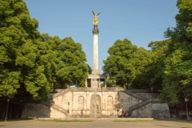
An evening by the Friedensengel is a romantic experience. Nowhere else in Munich does the sun disappear so impressively behind the city rooftops. The golden statue raises its wings above visitors towards the sky as the lights of a fountain start to sparkle in the water below.
The 38-metre-high monument of Nike, the Greek goddess of victory, is a bit like the city’s guardian angel. It calls for peace – even more so than its counterpart in Berlin, which is dedicated to the victory in the Franco-Prussian War of 1870 and 1871. The Friedensengel in Munich was erected later – in memory of 25 years of peace following the same war.
Its greatest aspect is its location: The golden statue towers atop a 23-metre Corinthian column in the middle of the Maximiliansanlagen, a park with mighty trees in the district of Bogenhausen. The column itself sits on top of an ancient-looking square temple. Visitors have the city at their feet: They can see the magnificent buildings on Prinzregentenstrasse, such as the Bavarian National Museum and the Haus der Kunst (art gallery), all the way up to the Prinz Carl Palais mansion.

The six-metre-high golden angel holds an olive branch in her right hand as a symbol of peace. In her left hand, she holds a figure of the goddess Athena, representing warfare and wisdom. The temple beneath measures eight by eight metres and features four gold mosaics that depict war, victory, peace and cultural blessings. Its cornerstones are adorned with portraits of emperors, chancellors and generals like Emperor Wilhelm I and King Ludwig II.
Two stairways lead from the Prinzregent-Luitpold-Terrasse observation deck to the fountain below. The water fountain visually extends the column towards the goddess of victory above. Four scantily dressed baroque cherubs can be seen riding dolphins in the water. In a niche in the stairway behind the fountain, the water drips less wildly in an artificial grotto – it used to be fashionable to recreate nature in this way.
The bronze statue created by the sculptors Heinrich Düll, Georg Pezold and Max Heilmaier was once in grave danger, as the Friedensengel threatened to collapse some decades after it had been unveiled on July 16, 1899. It was dismounted for safety reasons in 1981. It suffered serious damage in the process, and so it was only able to return to its place in 1983 – with a significantly stronger pillar and two new wings that are steeper than the previous ones and have a span of five metres.
The city of Munich mended and polished all its intricate features again to mark its 100th anniversary in 1999. Ferdinand von Miller’s bronze casting was given a fresh gold leaf dress and new radiance for its peacekeeping mission.